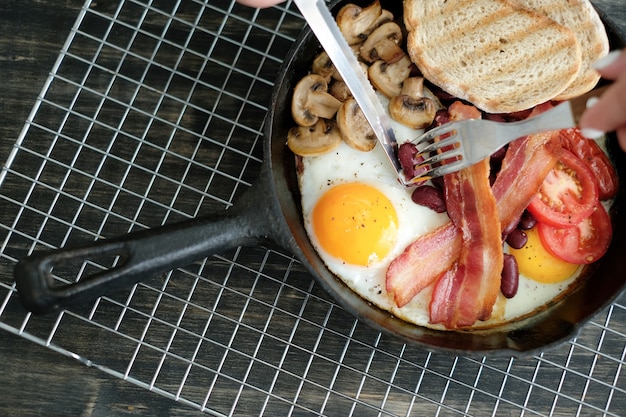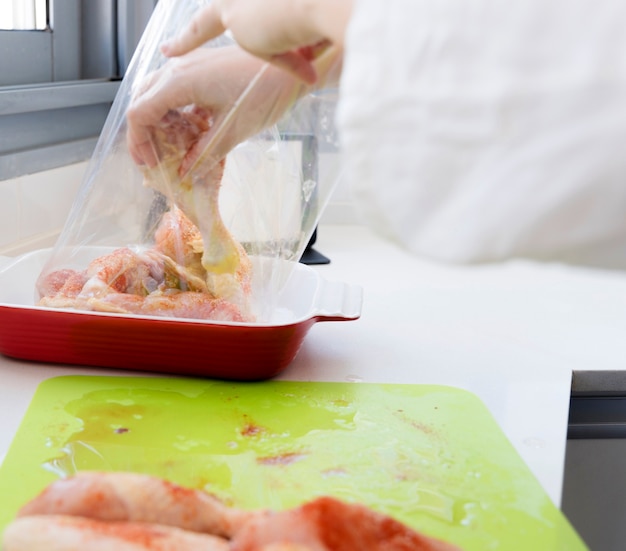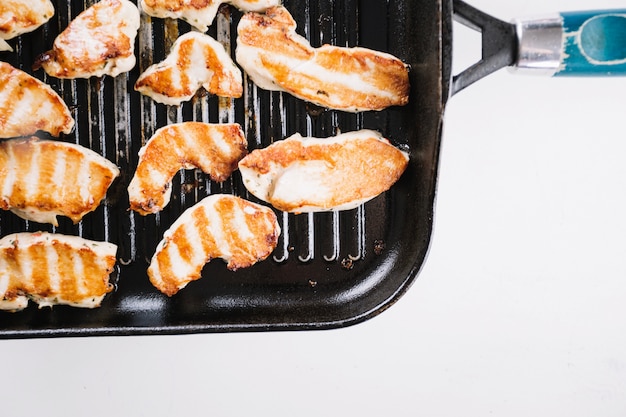There's a certain symphony of sounds and smells that instantly conjure up images of a perfect breakfast: the sizzle of a hot pan, the gentle crackle of bacon, the aroma of coffee brewing. But achieving that symphony's star performer – perfectly crispy bacon – is an art form, requiring a delicate balance of heat, time, and a dash of intuition. For years, I've been on a quest to master the art of frying bacon, experimenting with different techniques, pan types, and even the bacon itself. So, let's dive into the world of crispy bacon, exploring the nuances of each step, from choosing the right pan to understanding the subtle differences between bacon styles.
(Part 1) The Pan Method: A Classic for a Reason

The trusty frying pan is the backbone of countless culinary masterpieces, and bacon is no exception. It's the method most of us grew up with, and its simplicity allows for experimentation and personal preference. But achieving that perfect crisp requires a deep understanding of the pan method's secrets. Here's how I break down the process:
1. The Right Pan for the Job
The saying "you can't make an omelet without breaking eggs" applies to bacon too! The foundation of any good bacon fry is a quality pan. cast iron skillets are my personal go-to. Their ability to distribute heat evenly and retain it well is crucial for consistent cooking. You'll avoid those pesky unevenly cooked patches that often lead to disappointingly soggy bacon. If you don't have a cast iron skillet, a heavy-bottomed stainless steel pan is a solid alternative. But steer clear of flimsy non-stick pans – they tend to lose heat quickly, making it difficult to reach the high temperatures necessary for that satisfying crisp.
2. The Art of Preheating
Just like a good oven, a hot pan is essential for achieving crispy bacon. Preheating is a vital step, creating a searing environment that encourages the bacon to cook evenly and develop that golden-brown, crackly exterior. I typically set my burner to medium-high heat, aiming for a pan hot enough to make a drop of water sizzle instantly. It's a simple test that ensures the pan is ready to tackle the bacon.
3. The Bacon Layout: Avoiding Crowding
Remember that old adage: "too many cooks spoil the broth"? The same applies to bacon. Crowding the pan leads to steam build-up, creating a sauna-like environment for your bacon, which translates to soggy, rather than crispy, results. Instead, arrange your rashers in a single layer, leaving some space between each one. It's like giving each piece of bacon room to breathe and develop that beautiful, crisp exterior. If you have a large batch of bacon, cook it in batches. You'll thank me later.
4. The Flipping Technique: A Matter of Preference
Now, this is where the debate begins. Some swear by flipping the bacon halfway through cooking. But after years of experimentation, I've come to prefer letting the bacon rest undisturbed as long as possible. It allows the fat to render out properly and helps create that beautiful, crispy surface. I do keep an eye on the underside, ensuring it's not burning. Once it's golden brown and the fat is rendering nicely, I give it a flip. It's a gentler approach that ultimately yields better results.
5. The Timing Game: Mastering the Art of Patience
Timing is everything when it comes to bacon. The ideal cooking time varies depending on the thickness of your bacon. Thin bacon typically requires around 3-5 minutes per side, while thicker rashers need a bit longer, about 5-7 minutes per side. But remember, every piece of bacon is unique. Keep an eye on it, and adjust the cooking time accordingly. It's far better to undercook than overcook. Remember, a little patience goes a long way in the quest for crispy bacon.
6. The Drain-and-Crisp Trick: Maximizing Crispness
Once the bacon is golden brown and perfectly crispy on both sides, it's time for the final touch. I transfer the bacon to a wire rack set over a baking sheet. This allows the fat to drain completely, preventing the bacon from becoming soggy. It also allows for a little extra crispiness, especially if you're aiming for that ultimate crunch. For the truly dedicated, you can even pop the bacon under a preheated broiler for a minute or two. Just be careful not to burn it!
(Part 2) Alternative bacon cooking methods: Expanding Your Horizons

While the frying pan remains a classic for good reason, there are other methods that can deliver delicious, crispy bacon. Each method has its unique advantages and drawbacks, so it's important to consider your individual preferences and needs.
1. The oven method: A Hands-Off Approach
For those who prefer a more hands-off approach to cooking, the oven offers a convenient alternative. Preheat your oven to 400°F (200°C) and line a baking sheet with foil or parchment paper. Arrange the bacon in a single layer, making sure they're not touching. Bake for 15-20 minutes, flipping halfway through, until the bacon reaches your desired level of crispness. This method is ideal for larger batches of bacon, as it prevents splattering and is a great option for busy mornings when time is of the essence.
2. The Air Fryer: The Speedy Option
Air fryers have become increasingly popular in recent years, and they offer a quick and efficient way to cook bacon. Line the air fryer basket with parchment paper, arrange the bacon in a single layer, and cook for 5-8 minutes, flipping halfway through. The exact time will vary depending on your air fryer model and the thickness of the bacon, but the results are almost always satisfyingly crispy. Just remember to keep an eye on it and adjust the cooking time as needed.
(Part 3) Exploring Different Bacon Styles: Beyond the Ordinary

Bacon isn't just bacon, is it? There's a vast world of varieties, each with its own unique flavour and texture. Choosing the right type of bacon can elevate your bacon experience, adding a new layer of complexity and enjoyment. Here are a few popular types to consider:
1. Traditional smoked bacon: The Classic Choice
The king of bacon, smoked bacon is a true classic. Its distinctive flavour and aroma come from a meticulous curing process using salt, sugar, and smoke. This process also tends to produce a thicker bacon, which contributes to its richness and saltiness. For true bacon aficionados, there's nothing quite like the smoky, salty satisfaction of a well-cooked rasher of smoked bacon.
2. unsmoked bacon: A Milder Option
For those who prefer a more delicate flavour, unsmoked bacon offers a clean, unadulterated taste. Without the smoky notes, its natural pork flavour shines through. It's often preferred for recipes where the bacon's flavour shouldn't be overpowering, allowing other ingredients to take centre stage.
3. Canadian Bacon: The Leaner Alternative
Don't be fooled by its name – Canadian bacon isn't a completely different species! It's made from a pork loin, not belly, which makes it leaner and has a milder flavour than regular bacon. The curing process also gives it a unique texture. It's often used in breakfast sandwiches and salads, adding a touch of protein and salty flavour without being overly heavy.
4. thick-cut bacon: Indulgent and Meaty
For the ultimate bacon indulgence, thick-cut bacon is the way to go. Its chunkier size and higher fat-to-meat ratio result in a more pronounced flavour and a satisfyingly chewy texture. It takes longer to cook than thinner bacon, but the wait is worth it for the delightful combination of texture and taste. Thick-cut bacon is ideal for those who want a substantial, flavourful experience.
(Part 4) Going Beyond the Basic: Exploring Flavour Variations
Bacon is a versatile ingredient, and its flavour can be amplified with a little creativity. Why settle for plain bacon when you can add a touch of sweetness, a hint of spice, or a burst of freshness? Here are a few flavour variations that will elevate your bacon game:
1. The Sweet and Smoky Combo: maple-glazed bacon
Maple syrup and bacon are a culinary power couple, their flavours complementing each other beautifully. Before cooking, brush the bacon with a mixture of maple syrup and a touch of smoked paprika. This creates a sweet, smoky glaze that caramelizes during cooking, transforming ordinary bacon into a delectable treat. The sweetness balances the saltiness of the bacon, making it a perfect accompaniment to pancakes, waffles, or even a simple breakfast sandwich.
2. A Touch of Spice: Chipotle Bacon
For those who enjoy a little heat, chipotle powder adds a smoky, spicy kick to bacon. Before cooking, simply rub the bacon with a teaspoon of chipotle powder, adjusting the amount to your preference. The spice complements the smoky flavour of the bacon beautifully, creating a flavour profile that's both satisfying and complex. This spicy bacon is perfect for adding a touch of heat to salads, sandwiches, or even a simple bowl of soup.
3. A Mediterranean Twist: Herb-Infused Bacon
For a fresh, fragrant twist, infuse your bacon with the aromas of the Mediterranean. Combine rosemary, thyme, and oregano in a bowl, then rub the mixture onto the bacon. The herbs add a delicate, earthy flavour that complements the bacon perfectly. It's a perfect addition to salads, pasta dishes, or simply as a delicious snack.
4. A Spicy Surprise: Sriracha Bacon
For a bold, spicy flavour, try a sriracha glaze. Combine a tablespoon of sriracha sauce with a teaspoon of brown sugar and a pinch of salt. Brush the bacon with this glaze before cooking, creating a sweet and spicy treat. The sriracha glaze adds a touch of heat and a vibrant red colour, making it a striking and flavourful addition to any dish.
(Part 5) Bacon Beyond the Plate: Creative Uses
Bacon isn't just a breakfast staple. Its versatility allows it to shine in a variety of dishes, from appetizers to main courses. So, break free from the breakfast plate and explore the world of bacon's endless possibilities.
1. Bacon-Wrapped Dates: A Sweet and Savoury Treat
The combination of sweet dates and salty bacon creates a harmonious balance of flavours that is both surprising and satisfying. Wrap a pitted date with a slice of bacon and secure it with a toothpick. Bake in a preheated oven at 375°F (190°C) for 10-15 minutes, or until the bacon is cooked and the dates are softened. These little bundles of flavour are perfect as a party appetizer or a decadent after-dinner treat.
2. Bacon-Wrapped Asparagus: A Healthy and Delicious Side
For a healthy and flavorful side dish, wrap fresh asparagus spears with a slice of bacon and secure them with a toothpick. Bake in a preheated oven at 400°F (200°C) for 15-20 minutes, or until the bacon is cooked and the asparagus is tender-crisp. The bacon adds a delicious smoky flavour to the asparagus, creating a delightful contrast of textures and tastes. This dish is a great way to add some excitement to any meal.
3. Bacon-Crusted Chicken: A Hearty and Satisfying Main Course
Turn ordinary chicken breasts into a culinary masterpiece with a crispy bacon crust. Coat the chicken breasts with a mixture of breadcrumbs, grated Parmesan cheese, and crumbled bacon. Bake in a preheated oven at 400°F (200°C) for 25-30 minutes, or until the chicken is cooked through and the crust is golden brown. The bacon adds a salty, smoky flavour to the chicken, making it a satisfying and flavourful main course.
(Part 6) The Importance of Good Quality Bacon: Getting the Basics Right
You can't expect a perfect symphony from out-of-tune instruments, and the same applies to bacon. Choosing good quality bacon is essential for achieving the best results. Here's a guide to selecting the finest bacon for your culinary endeavors:
1. Look for Thick-Cut Bacon
Thick-cut bacon is a true investment in flavour and texture. It typically has a better fat-to-meat ratio, which means it cooks more evenly and develops a more satisfying, chewy texture. It's also less likely to dry out during cooking, ensuring every bite is juicy and flavorful.
2. Choose Bacon with Minimal Additives
Avoid bacon loaded with excessive amounts of sugar, salt, or artificial ingredients. These additives can mask the natural flavour of the bacon and leave a less satisfying taste. Look for bacon that is simply cured with salt, sugar, and smoke, allowing the pure flavour of the pork to shine through.
3. Check the Packaging
Pay attention to the packaging. Look for bacon that is vacuum-sealed or in a protective atmosphere packaging. This helps preserve the freshness and quality of the bacon, ensuring it retains its flavour and texture.
4. Trust Your Nose
Your sense of smell is a powerful tool when choosing bacon. Fresh bacon should have a pleasant, smoky aroma. If it smells off or rancid, it's best to avoid it. A fresh, appealing scent is a good indicator of quality bacon.
(Part 7) The Art of Storing Bacon: Keeping it Fresh
Proper storage is crucial for keeping your bacon fresh and flavorful. Here are a few tips to ensure your bacon stays in top condition:
1. Refrigeration is Key
Bacon should always be stored in the refrigerator. Ideally, it should be placed in the coldest part of the fridge, away from fluctuating temperatures. Avoid storing it in the door, as the temperature changes can affect its quality and freshness.
2. Wrap it Tight
To prevent the bacon from drying out, wrap it tightly in plastic wrap or aluminum foil. You can also store it in a freezer-safe bag. The key is to keep it sealed and protected from air.
3. Freeze for Longer Storage
If you need to store bacon for longer than a few days, freezing is the best option. Wrap the bacon tightly in plastic wrap and then place it in a freezer-safe bag. frozen bacon can be kept for up to 3 months, retaining its quality and flavor.
(Part 8) FAQs: Your Bacon Questions Answered
Every bacon enthusiast has their own set of questions. Here are some common inquiries and their answers, helping you navigate the world of crispy bacon:
1. How Do I Prevent Bacon From Curling?
Bacon curling is a common problem, caused by uneven fat rendering. To prevent this, try weaving a toothpick through the bacon rashers before cooking. This helps hold them flat and prevents them from curling up during cooking. You can also try placing a heavy object, like a saucepan, on top of the bacon while it's cooking, gently pressing it down to prevent curling.
2. Can I Cook Bacon in the Microwave?
Yes, you can cook bacon in the microwave, but it won't be as crispy as pan-fried or oven-baked bacon. If you're in a hurry, it's a convenient option. There are special microwave bacon trays available that help to distribute heat evenly and produce a crispier result. However, it won't have the same satisfying crunch as the traditional methods.
3. How Do I Dispose of bacon grease?
Bacon grease is a culinary treasure! It can be used for cooking other dishes, adding flavour to vegetables, or even making homemade soap. Let the grease cool completely, then strain it through a cheesecloth or coffee filter to remove any solid particles. Store the filtered grease in an airtight container in the refrigerator for up to a month, or freeze it for longer storage. If you don't want to keep the grease, dispose of it in a sealed container in the trash.
4. Can I Cook Bacon Without Fat?
Yes, you can cook bacon without fat. Try cooking it in a nonstick pan sprayed with cooking spray. However, the bacon won't be as crispy as when cooked with its own fat. You can also use a little bit of olive oil or avocado oil to help the bacon cook evenly and achieve some crispness. But the flavour won't be the same.
5. What are the Healthier Options for Bacon?
Bacon is high in saturated fat, so it's not the healthiest choice. However, there are some healthier alternatives available. Look for bacon made with turkey, chicken, or plant-based ingredients. These options are lower in fat and calories, but they might not have the same flavour as traditional pork bacon.
Ultimately, the quest for the perfect crispy bacon is a journey of discovery. Experiment with different methods, bacon styles, and flavour variations, and you'll find yourself on a path to bacon bliss. So, grab your spatula, choose your bacon, and let the symphony of crispy perfection begin!
Everyone is watching

How to Cook Frozen Lobster Tails Perfectly: A Step-by-Step Guide
RecipesLobster. Just the word conjures up images of lavish meals, special occasions, and a taste of luxury. But let's...

Pigs in a Blanket Cooking Time: How Long to Bake for Perfect Results
RecipesAh, pigs in a blanket. Just the name conjures up images of those delightful little parcels of crispy pastry en...

Pork Fillet Cooking Time: How Long to Cook It Perfectly
RecipesPork fillet, or tenderloin as it's sometimes called, is a real favourite in our house. It's so versatile, and...

The Ultimate Guide to Cooking Delicious Frankfurters
RecipesLet's face it, we all love a good frankfurter. It's a classic, simple, and always satisfying. But let's be rea...

Wolf Meat Recipes: A Guide to Cooking Wild Game
RecipesLet's be honest, you don't see wolf meat at your local butcher shop every day. It's a bit of a wild card, but ...
